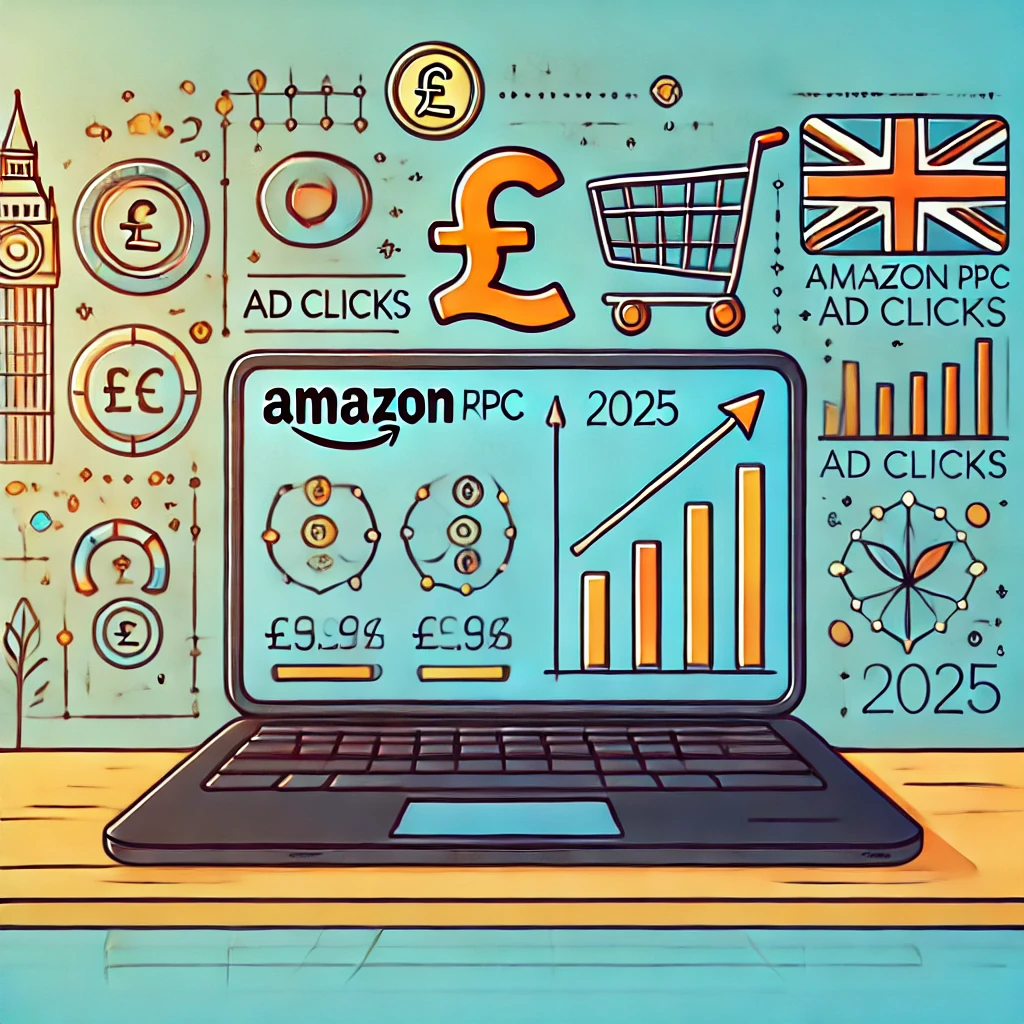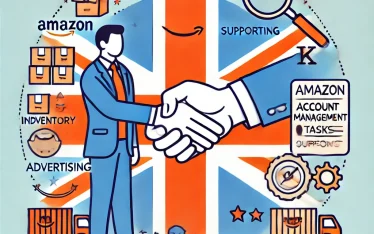TL;DR
- Amazon’s AI-powered bid automation helps sellers optimize spend and improve ad efficiency effortlessly.
- Video and interactive ads now dominate, making static image ads less effective for Amazon PPC campaigns.
- Amazon ads now appear on Pinterest and BuzzFeed, expanding reach beyond Amazon search for more visibility.
- AI creative tools let sellers generate high-quality images and videos without needing design expertise.
- Amazon Marketing Cloud gives deeper insights into ad performance, improving targeting and bid strategies.
- Smart PPC and external traffic strategies help sellers lower ACoS, improve ranking, and boost profitability.
If you’re an Amazon seller in the UK, your PPC strategy needs to be sharper than ever in 2025. Amazon is rolling out updates that could impact how your ads perform, how much you pay, and how you optimize your campaigns. Some of these changes might work in your favor—like AI-driven placements and smarter budget allocation—while others might make the competition even tougher.
The good news? If you stay ahead of these updates, you can fine-tune your ad spend, improve conversions, and make sure you’re not wasting money on ineffective campaigns. In this blog, we’ll break down the key changes in Amazon PPC for UK sellers in 2025 and how you can adjust your strategy to stay profitable.
Quick guide:
- Why Amazon PPC is evolving in 2025
- Key changes in Amazon PPC for UK sellers
- Amazon PPC tips for 2025 (from
Why Amazon PPC is evolving in 2025
Amazon’s advertising system is always changing, and 2025 is no different. The competition among sellers is growing, more brands are investing in ads, and Amazon itself is bringing in new technology to improve the shopping experience.
One of the biggest reasons for this shift is AI and automation. Amazon is using smarter algorithms to decide when and where to show ads, making the bidding process more dynamic. At the same time, customer behavior is changing. Shoppers expect more engaging ads, like videos and interactive content, rather than just plain product listings.
Amazon is also adjusting PPC rules to make sure ads are more relevant and useful. This means strategies that worked last year might not be as effective now. Sellers need to rethink their PPC game—focusing more on high-quality content, smart targeting, and cost-effective bidding. Many brands are now looking for Amazon pay per click advertising management services to help navigate these changes, ensuring their ad spend is optimized for maximum ROI.
In short, if you’re running ads in 2025, you can’t just “set and forget” your campaigns. You need to stay updated, test new strategies, and adapt quickly to keep up with the changes.
Key changes in Amazon PPC for UK sellers
Amazon has rolled out some big updates for PPC in 2025, and these aren’t just minor tweaks. These changes can impact how you target customers, how you create ads, and where your ads appear. Let’s break down each update in a way that makes sense—so you know exactly how to use them to your advantage.
#1: Enhanced targeting capabilities
Amazon is giving sellers more control over who sees their ads. Now, you can target customers based on demographics, interests, and past purchases in Sponsored Brands campaigns.
- What this means for you: Instead of wasting ad spend on people who aren’t interested, you can fine-tune your audience. Want to target young professionals who buy fitness gear? Or are parents shopping for baby products? Now you can. This update helps sellers improve conversions because your ads will be seen by people who are likely to buy.
#2: New ad formats – video and interactive ads to grab attention
Amazon is going beyond boring text ads. Video and interactive ads are now part of Sponsored brand campaigns, making it easier to tell your brand story in a way that stands out.
- What this means for you: If you’re still using basic image ads, you’re missing out on engagement. Shoppers scroll fast, and static images don’t always catch their eye. But a short, high-quality video? That can stop them mid-scroll and get them to click. If you want to boost your brand presence, video ads are a must.
#3: AI-powered creative tools
Creating ads is easier than ever with Amazon’s AI-driven tools. The AI image generator now creates high-quality lifestyle images, and soon, an AI-powered video generator will let you make professional-looking videos without hiring a designer.
- What this means for you: If you don’t have the time or skills to make stunning ad creatives, Amazon’s AI tools do the heavy lifting for you. You can quickly create eye-catching images and videos that look like they were made by a professional. This saves time and helps small sellers compete with big brands that have massive marketing budgets.
#4: Event-based bid automation
Amazon is introducing event-based bid rules, meaning you can set your bids to automatically adjust during key shopping events, like Prime Day, Black Friday, or seasonal sales.
- What this means for you: No more stressing over bid changes the night before a big sale. You can schedule bid increases in advance to stay competitive when traffic spikes, ensuring your ads remain visible without constantly monitoring them. This helps maximize sales during high-demand periods while keeping costs under control.
#5: Expanded advertising reach
Amazon has partnered with external sites like Pinterest and BuzzFeed, allowing Sponsored product ads to show outside of Amazon. This means shoppers might see your product on popular blogs, social media platforms, or news sites and be redirected to your Amazon listing.
- What this means for you: More exposure for your products without extra effort. This is great for sellers in competitive niches, as it helps you reach potential customers before they even start searching on Amazon. If your competitors are only focusing on Amazon traffic, you gain an advantage by being visible in more places.
#6: Amazon Marketing Cloud integration
Amazon has improved its Marketing Cloud integration, giving sellers deeper data insights on their campaigns. Now, you can track how shoppers interact with your ads across different touchpoints and adjust your strategy accordingly.
- What this means for you: Instead of guessing what’s working, you get clear data on customer behavior. You can see which ads drive the most conversions, which keywords are performing best, and where you’re losing potential buyers. This helps you optimize your PPC campaigns and make smarter marketing decisions.
Amazon PPC tips for 2025 (from Amazon advertising specialists)
- Set up multiple campaigns for the same product
- Exact match campaign – Focus on high-converting keywords to control spending.
- Phrase match campaign – Capture long-tail searches for better visibility.
- Broad match campaign – Discover new keyword opportunities but keep bids lower.
- ASIN targeting campaign – Target competitor listings where your product has an advantage.
This setup helps you track performance separately and shift the budget to the most effective campaign type.
- Always use negative keywords to reduce wasted ad spend
Identify keywords that bring in irrelevant traffic and add them as negative exact matches or negative phrase matches to prevent unqualified clicks.
- Check your search term report weekly.
- Look for high-spend, low-conversion keywords.
- Add irrelevant or low-performing terms to the negative list immediately.
This prevents wasted ad spend and keeps ACoS under control.
- Use bid adjustments instead of manual bid increases everywhere
Instead of increasing bids across the board, use placement bid adjustments to optimize where your ads show:
- Increase bids for Top of Search if conversion rates are higher there.
- Lower bids for the Rest of the Search or Product Pages if ACoS is too high.
- Test bid adjustments gradually instead of making large jumps.
This helps you get more conversions without overspending.
- Don’t rely on auto campaigns alone—use them for keyword discovery
Auto campaigns are useful, but they shouldn’t be your main PPC strategy. Use them to find converting keywords, then move those keywords to a manual exact match campaign with controlled bids.
- Let an auto campaign run for at least 2 weeks to gather data.
- Identify high-converting keywords.
- Add those keywords to a manual campaign and set bid control.
- Add those keywords as negatives in the auto campaign to prevent duplicate spending.
This ensures your budget goes to high-performing keywords instead of being spread too thin.
- Optimize bids based on conversion data, not just ACoS
Many sellers only look at ACoS when adjusting bids, but conversion rate (CVR) is equally important.
- If a keyword has a high ACoS but a strong conversion rate, lower the bid slightly instead of pausing it.
- If a keyword has a low conversion rate, reduce bids aggressively or pause it.
- If a keyword has a high click volume but no conversions, consider making it a negative keyword.
This approach prevents you from cutting profitable keywords too soon and keeps spending efficient.
- Use Amazon’s AI-powered tools to generate images and videos
Amazon now offers AI image and video creation tools to help sellers build engaging ads faster.
- Test video ads in Sponsored Brands for better engagement.
- Use lifestyle AI-generated images to improve click-through rate (CTR).
- If your main image isn’t converting, test AI-generated variations to see if performance improves.
Amazon’s algorithm favors high-engagement ads, so better visuals can directly improve ad ranking and conversions.
- Scale winning campaigns with budget automation
Once you identify profitable campaigns, use Amazon’s budget automation tools to ensure they keep running at optimal levels.
- Set budget rules to increase daily spending automatically for high-performing campaigns.
- Use event-based bidding to increase bids during Prime Day, Black Friday, and seasonal sales.
- Monitor performance closely and adjust caps to avoid overspending.
This prevents campaigns from running out of budget on high-converting days.
- Avoid bidding wars—monitor competitor pricing before increasing bids
If your competitor lowers their price, your conversion rate may drop. Before raising bids, check:
- If your price is competitive – If not, adjust pricing before increasing PPC spend.
- If competitors are running promotions – If they are, expect temporary lower conversions.
- If your reviews are lower than competitors – If so, work on review strategies before spending more on ads.
Bidding higher doesn’t always fix a drop in conversions. Make sure price and social proof support your ad spend.
- Use Sponsored Display ads to retarget high-intent shoppers
Amazon allows you to retarget shoppers who viewed your listing but didn’t buy. This can help recover lost sales.
- Set up a Sponsored Display campaign targeting “Views Remarketing.”
- Target shoppers who visited your product page in the last 7 to 14 days.
- Adjust bids based on the performance of these retargeting campaigns.
This ensures you stay visible to customers who already showed interest in your product.
- Refresh ads every 60-90 days to prevent ad fatigue
Amazon shoppers see thousands of ads daily, and over time, your ads may lose effectiveness.
- Test new images and different ad copy in Sponsored Brands.
- Experiment with different video lengths for Sponsored Video ads.
- Rotate new headlines to see which messaging drives the most engagement.
Refreshing creatives keep your campaigns performing well and prevent a decline in CTR.
- Track performance beyond ACoS—look at TACoS
Total Advertising Cost of Sales (TACoS) helps you understand the true impact of PPC on total sales.
- If TACoS is dropping while revenue is increasing, your ads are driving organic sales growth.
- If TACoS is rising without an increase in total sales, your PPC strategy needs adjusting.
- Focus on long-term profitability rather than just cutting ACoS in the short term.
A healthy TACoS shows that ads are contributing to overall business growth, not just short-term revenue.
- Don’t rely only on Amazon ads—combine PPC with external traffic
External traffic signals help boost your product ranking, which can improve your organic and paid results.
- Use Google Ads to drive traffic to your listing.
- Send targeted social media traffic from Facebook, Instagram, or Pinterest ads.
- Use email marketing to push past customers back to your listing.
Amazon favors products that bring in external traffic, which can lead to better ad placements and lower CPCs.
See you next week!
Amazon PPC isn’t just about increasing bids and spending more. The key to success in 2025 is data-driven optimization, smart targeting, and automation. Sellers who use AI tools, refresh creatives, and make strategic bid adjustments will see better results while keeping costs under control. With competition getting tougher, many sellers are now turning to Amazon consultants to refine their PPC strategy, improve ad efficiency, and maximize profitability. With the right approach, PPC can be a profit driver, not just an expense.










